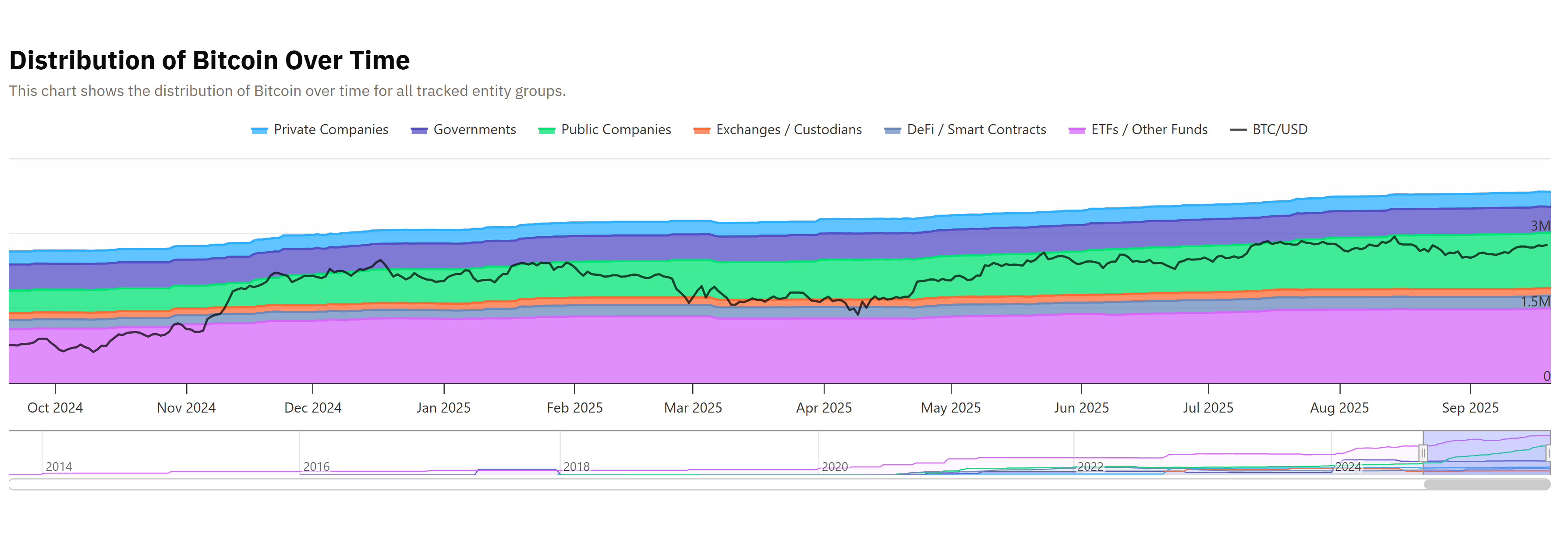Digital asset treasuries (DATs) are corporate reserves of cryptocurrencies managed as strategic, operational assets rather than speculative bets. HashKey Capital CEO Deng Chao says DATs require formal risk frameworks, governance and liquidity planning to remain sustainable through volatile market cycles.
-
DATs must be treated as strategic reserves with governance and risk limits.
-
HashKey launched a $500 million DAT fund targeting BTC and ETH along with custody and staking services.
-
Spot Bitcoin ETFs hold $152.31 billion; public companies hold 1,111,225 BTC (≈ $128 billion) — data: SoSoValue, BitcoinTreasuries.NET.
Digital asset treasuries (DATs): treat crypto as strategic reserves with governance and liquidity planning — learn how HashKey’s $500M DAT fund approaches treasury risk.
What are digital asset treasuries (DATs) and how should companies manage them?
Digital asset treasuries (DATs) are corporate holdings of cryptocurrencies held for operational use or strategic reserve purposes. Effective DAT management requires documented risk frameworks, diversification across BTC/ETH, and operational controls to manage liquidity, custody and accounting treatment.
How did HashKey Capital describe DAT sustainability?
HashKey Capital CEO Deng Chao told Cointelegraph that DATs can be sustainable long-term if they are governed with discipline. He emphasized that failures typically stem from poor risk frameworks, overconcentration, or treating holdings as speculative investments rather than strategic reserves.
HashKey Capital CEO Deng Chao says crypto treasuries must be treated as strategic reserves, not speculative bets, to remain sustainable in volatile cycles.
The survival of corporate crypto treasuries depends on governance and discipline, according to HashKey Capital CEO Deng Chao.
In an interview with Cointelegraph, Chao argued that digital asset treasuries are sustainable long-term but carry an important caveat: inadequate risk frameworks and poor diversification turn DATs into speculative exposures vulnerable to market cycles.
“Resilience comes from discipline,” he said. “Digital assets themselves are not inherently unsustainable; it is how they are managed that makes the difference.”
The comment followed the launch of HashKey’s $500 million DAT fund in Hong Kong. The vehicle targets corporate treasuries holding Bitcoin and Ethereum and will deploy capital across onchain infrastructure, custody, staking, and regulated stablecoin infrastructure to support operational use of digital assets.
The fund is designed for institutions and corporations that want not only to hold crypto but to capture value from the growth of underlying infrastructure.
DATs vs. ETFs: different tools, different goals
Chao drew a practical distinction: ETFs provide simple market exposure for mainstream investors, while DATs are treasury instruments built to integrate crypto into corporate operations and reserves. According to SoSoValue data, spot Bitcoin ETFs hold a combined $152.31 billion, representing 6.63% of Bitcoin’s market capitalization. Public companies hold 1,111,225 BTC on their balance sheets — about $128 billion per BitcoinTreasuries.NET.

All entities holding Bitcoin. Source: BitcoinTreasuries.NET
Many corporate treasuries have been burned by rigid fund structures or extreme volatility. HashKey’s DAT vehicle supports regular subscriptions and redemptions and includes exposure to both BTC and ETH to reduce concentration risk.
“Treasuries that have entered crypto have long struggled with two issues: liquidity and operations,” Chao said. “Our DAT fund was built to solve these pain points.”
HashKey plans to deploy capital across Bitcoin and Ethereum ecosystems, which the firm calls dual anchors for liquidity and innovation. Priority sectors include custody, payments, staking services, and regulated stablecoin infrastructure. The fund’s scope is international: launched in Hong Kong with target markets including the US, Japan, Korea, Southeast Asia and the UK.
Why do misconceptions block institutional adoption?
Chao noted that misconceptions — crypto is too speculative, hard to secure, or incompatible with accounting — create barriers to institutional adoption. Clear governance, custody standards and accounting guidance are essential to overcoming those barriers and enabling broader corporate adoption of DATs.
Looking ahead, Chao is bullish on tokenization of real-world assets (RWA), institutional OTC markets, and onchain financial product infrastructure. “Tokenized products expand the investable universe,” he said. “OTC markets provide channels for capital to flow at scale… This convergence signals a shift toward integrated digital finance.”
How should companies treat DATs as strategic reserves?
- Establish a formal risk policy: define allocation limits, stress testing scenarios and stop-loss rules.
- Diversify exposure: combine BTC and ETH with infrastructure allocations to reduce concentration risk.
- Ensure operational readiness: custody, reconciliation, and accounting processes must be in place before allocation.
- Maintain liquidity buffers: align treasury liquidity with redemption and operational needs.
- Governance and reporting: regular board-level reporting and independent audits of controls.
Frequently Asked Questions
How much capital do spot Bitcoin ETFs and public companies hold?
Spot Bitcoin ETFs hold approximately $152.31 billion (6.63% of Bitcoin’s market cap) per SoSoValue. Public companies collectively hold about 1,111,225 BTC, valued at roughly $128 billion per BitcoinTreasuries.NET.
What operational risks should treasuries prepare for?
Treasuries must prepare for custody failure, liquidity mismatches, accounting and tax treatment gaps, and governance shortfalls. Formal controls, insured custody solutions, and reconciliations help mitigate these risks when implemented before allocations.
Key Takeaways
- Governance matters: DATs require clear policies and board oversight to be sustainable.
- Liquidity and operations: practical custody and redemption mechanisms are essential for treasury use.
- Strategic allocation: treat crypto as operational reserves and invest in supporting infrastructure.
Conclusion
Digital asset treasuries can serve as strategic corporate reserves when governed with discipline, diversified across BTC and ETH, and backed by robust custody and liquidity planning. HashKey’s $500 million fund exemplifies an institutional approach focused on operational readiness and infrastructure investment — a model other corporations can adapt to integrate crypto responsibly.
Digital asset treasuries (DATs): treat crypto as strategic reserves with governance and liquidity planning — learn how HashKey’s $500M DAT fund approaches treasury risk.




